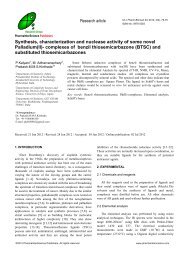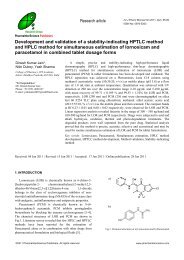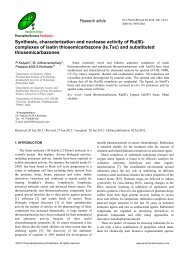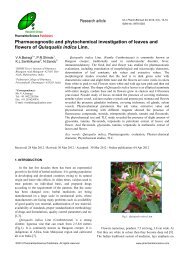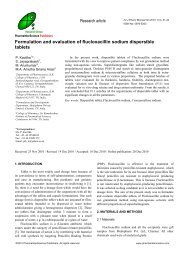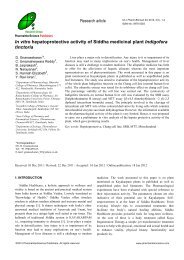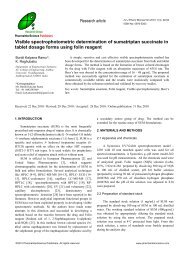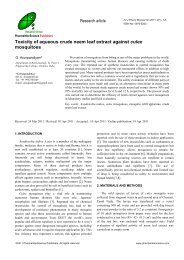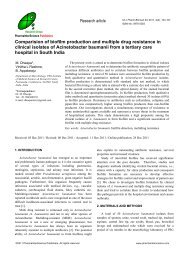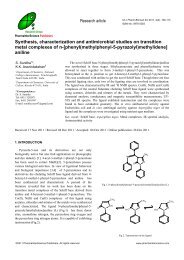A clinical study of vault hematomas after different types of ...
A clinical study of vault hematomas after different types of ...
A clinical study of vault hematomas after different types of ...
Create successful ePaper yourself
Turn your PDF publications into a flip-book with our unique Google optimized e-Paper software.
Hemant Deshpande et al, Int J Pharm Biomed Sci 2013, 4(3), 91-95<br />
92<br />
Table 1<br />
Indications for abdominal and vaginal hysterectomies<br />
Abdominal hysterectomy<br />
Vaginal hysterectomy<br />
Indication No. <strong>of</strong> cases No. <strong>of</strong> hematoma case (%) Indication No. <strong>of</strong> cases No. <strong>of</strong> hematoma case (%)<br />
Large multiple fibroids 10 2(20) UV prolapse 70 5(7.14)<br />
Fibroids 15 1(6.67) Fibroid 10 2(20)<br />
DUB 45 0(0) DUB 15 2(13.33)<br />
PID 21 3(14.29) Adenomyosis 5 2(40)<br />
Chronic cervicitis 5 1(20)<br />
Endometriosis 4 0(0)<br />
Total 100 7(7) 100 11(11)<br />
and laparoscopically assisted vaginal hysterectomies<br />
(LAVH), for <strong>different</strong> benign uterine diseases.<br />
Ethical committee permission was obtained for the <strong>study</strong>.<br />
All patients were <strong>clinical</strong>ly evaluated by detail history,<br />
thorough <strong>clinical</strong> examination, and needful investigations<br />
along with pre-operative ultrasound assessment.<br />
Preoperative assessment was done for high risk factors like<br />
hypertension, chronic intake <strong>of</strong> aspirin, ischemic heart<br />
disease, anticoagulant therapy, diabetes mellitus and<br />
coagulopathy for increased bleeding tendencies. After final<br />
diagnosis and indication for hysterectomy, decision regarding<br />
route <strong>of</strong> hysterectomy was decided, to group the patients.<br />
Hysterectomies were performed by <strong>different</strong> experienced<br />
gynaecologists. A single dose <strong>of</strong> intravenous antibiotic,<br />
Injection Cefixime 1 gm was given one hour pre-operatively.<br />
Suture material and suturing technique used for <strong>vault</strong> closure<br />
was recorded. Amount <strong>of</strong> blood loss, units <strong>of</strong> blood<br />
transfused and operative time were recorded for every<br />
patient. Type <strong>of</strong> haemorrhage, if present, was recorded as per<br />
type - primary, reactionary or secondary.<br />
Postoperative morbidity was assessed by complains like<br />
abdominal pain and distension, fever, weakness, bleeding and<br />
foul smelling discharge per vaginum. Postoperative vitals<br />
were noted twice a day in the form <strong>of</strong> pulse rate, temperature<br />
and blood pressure. Daily abdominal examination was<br />
performed for distension, tenderness, guarding and rigidity.<br />
Inspection <strong>of</strong> vulva was done daily for presence <strong>of</strong> any<br />
vaginal discharge. Per speculum examination under aseptic<br />
precautions was performed for the patients complaining <strong>of</strong><br />
bleeding per vaginum.<br />
Transabdominal and transvaginal ultrasound was<br />
performed in each case on 3 rd , 7 th and postoperative days<br />
and if required on subsequent follow up <strong>after</strong> 4 weeks.<br />
The size <strong>of</strong> any <strong>vault</strong> collection (non peristaltic complex<br />
echogenic mass) was noted and classified according to its<br />
mean diameter, i.e. small = 5cm. Patients with a detected pelvic<br />
hematoma were subjected to a follow up ultrasound scan<br />
<strong>after</strong> 7 days and onwards. Patients with large hematoma were<br />
subjected to the evacuation <strong>of</strong> hematoma, in a lithotomy<br />
position, with all aseptic precautions under anaesthesia.<br />
Procedure for draining hematoma was removal <strong>of</strong> central two<br />
sutures <strong>of</strong> the vaginal <strong>vault</strong> and if needed digital exploration<br />
and evacuation. Insertion <strong>of</strong> Penrose drain was considered if<br />
required. Patients with small <strong>hematomas</strong> were treated<br />
conservatively for spontaneous resolution and observed for<br />
any complications. Medium sized <strong>hematomas</strong> were treated<br />
with antifibrinolytic agents like tranaxemic acid with a dose<br />
<strong>of</strong> 500mg eight hourly intravenously or orally. Injectable<br />
antibiotics were added to prevent any superseded infection.<br />
The results were subjected to Chi-square test and Proportion<br />
test for significance.<br />
3. RESULTS<br />
Table 1 shows indications for abdominal and vaginal<br />
hysterectomies. Commonest indication for hysterectomy in<br />
group A was DUB, fibroid uterus and in group B was genital<br />
prolapse.<br />
Incidence <strong>of</strong> <strong>vault</strong> hematoma in our <strong>study</strong> was 11%<br />
following vaginal hysterectomy (VH). Maximum i.e. 45 out<br />
<strong>of</strong> 100 cases <strong>of</strong> abdominal hysterectomies were performed for<br />
DUB, none <strong>of</strong> them developed <strong>vault</strong> hematoma. Incidence <strong>of</strong><br />
<strong>vault</strong> hematoma was 7% <strong>after</strong> abdominal hysterectomy and<br />
it was more in patients who underwent total abdominal<br />
hysterectomies (TAH) for large multiple fibroids. Tyrone<br />
Carpenter reported in his <strong>study</strong>, in around 5% <strong>of</strong> patients,<br />
<strong>vault</strong> haematoma occured following abdominal hysterectomy<br />
[14]. Total laparoscopic hysterectomies (TLH) were<br />
performed in 20 patients, out them, two performed for fibroid<br />
and PID developed hematoma. Incidence <strong>of</strong> hematoma<br />
formation was 7.14% in patients with VH for uterine or<br />
uterovaginal prolapse.<br />
Table 2<br />
Incidence <strong>of</strong> Vault haematoma and granuloma in relation to type <strong>of</strong> VH<br />
Type <strong>of</strong> surgery<br />
©2013 PharmaInterScience Publishers. All rights reserved. www.pharmainterscience.com<br />
No. <strong>of</strong><br />
cases<br />
Vault<br />
hematoma<br />
Vault<br />
granuloma<br />
Abdominal procedures TAH 80 05(6.25%) 13(16.25%)<br />
TLH 20 02(10%) 02(10%)<br />
Total 100 07(7%) 15(15%)<br />
Vaginal procedures VH 20 02(10%) 02(10%)<br />
VH with repair 50 03(6%) 01(10%)<br />
LAVH 10 02(5%) 01(10%)<br />
NDVH 20 04(20%) 01(10%)<br />
Total 100 11(11%) 05(5%)




